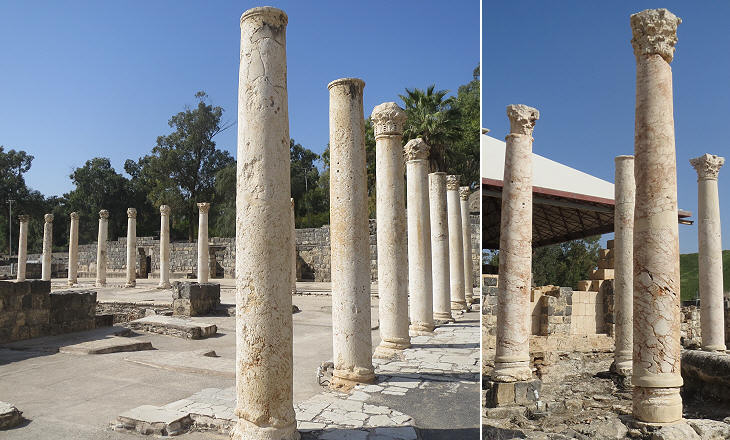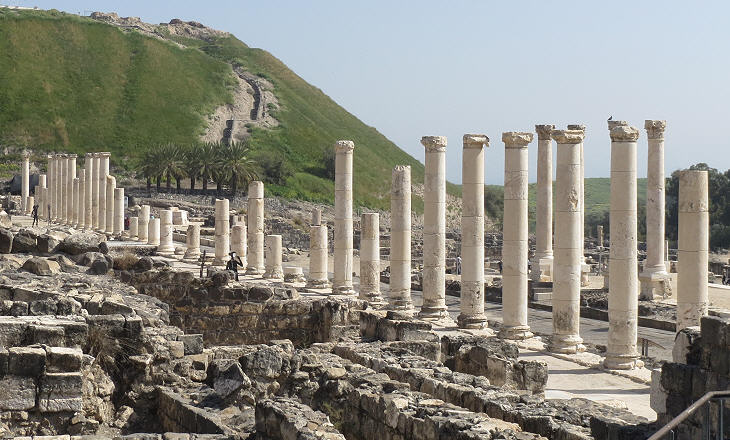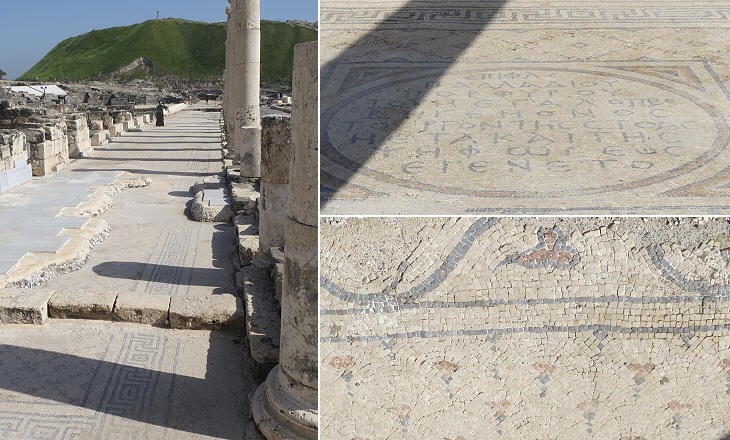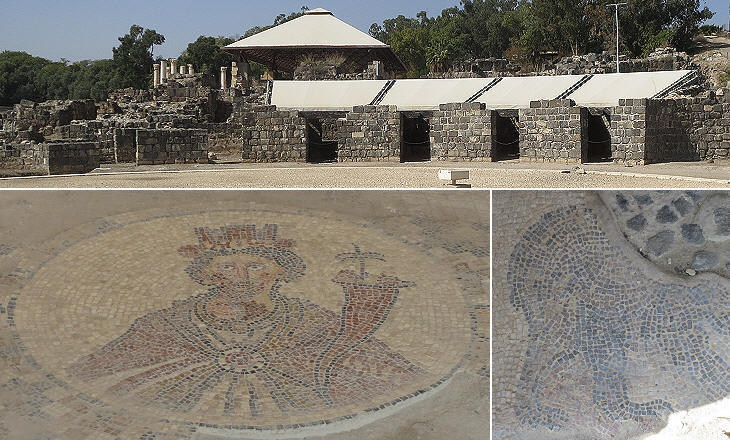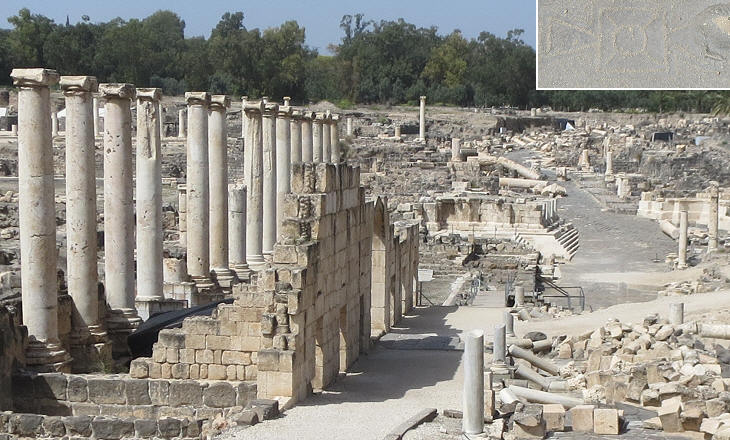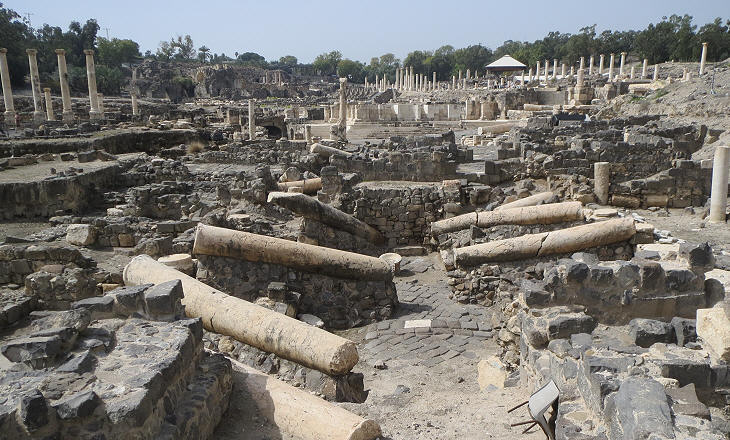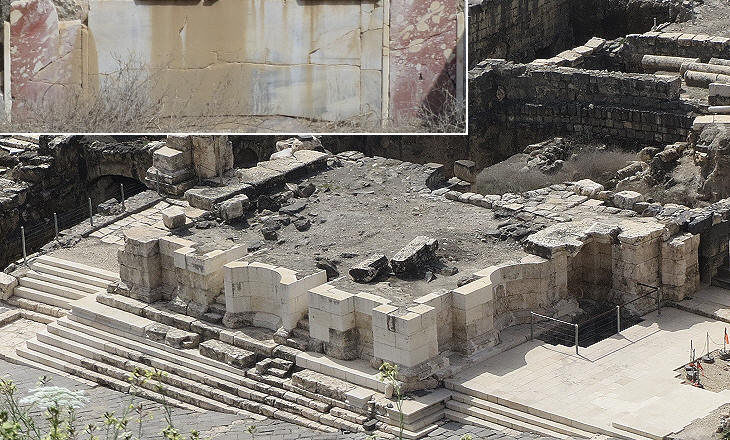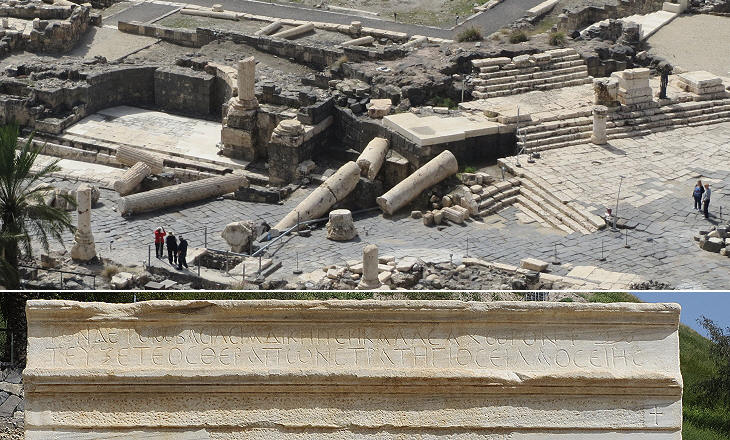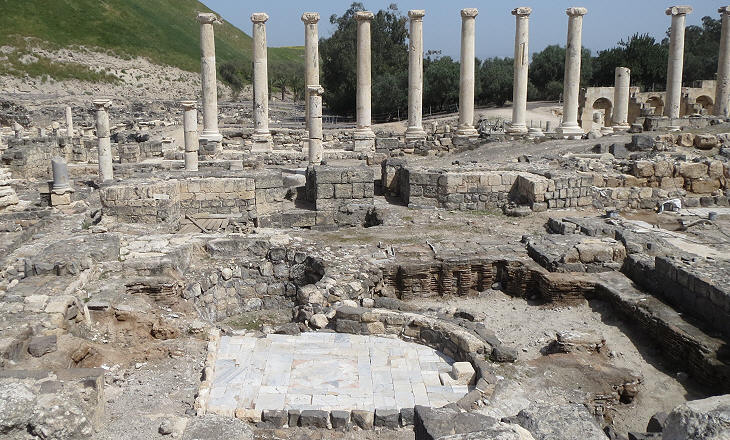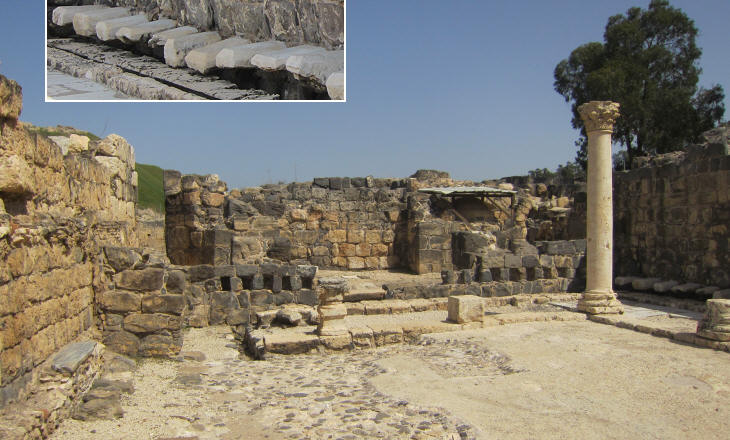  What's New! Detailed Sitemap All images © by Roberto Piperno, owner of the domain. Write to romapip@quipo.it. Text edited by Rosamie Moore. Page added in July 2013. |
 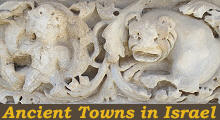 - Scythopolis - page two - Scythopolis - page two(relief at Scythopolis) If you came to this page directly, you might wish to read a page with an introduction to this section or page one first.
Probably Scythopolis reached its maximum development in the IInd/IIIrd centuries AD. Because the town continued to be an important centre well into the VIth century some of its monuments were restored/modified utilizing material from other buildings. The great courtyard of the Western Baths, probably a palaestra (wrestling school) was built in ca 400, but its columns came from previous buildings. You may wish to see another palaestra at Thuburbo Majus in Tunisia.
The Western Baths are located near one of the three main colonnaded streets of the town which was restored and embellished at approximately the same period. Scythopolis did not have walls until perhaps circa 530 when Emperor Justinian promoted a large plan of defensive fortifications. While at many locations the part of the town inside the walls was pretty small (e.g. Leptis Magna in Libya), at Scythopolis the enclosure was rather large and it did not impact on the urban layout. The decline of the town began in 542 when a bubonic plague spread in the region.
Evergetism (I do good things in Greek) is the word used by French historian André Boulanger to indicate the widespread practice of making donations for the embellishment of towns in the Graeco-Roman world. Celebratory inscriptions often make references to local magistrates such as the ediles (in charge of streets, bridges and similar facilities) and the flamines (in charge of promoting the image of Rome in the provinces), but in many cases the donors were just wealthy citizens. At Palmyra they were remembered by small statues on the columns they had contributed to erect, but when Palladius restored the street, statues were already regarded as part of the ancient pagan beliefs.
In 435 Emperor Theodosius II ordered the destruction of all pagan temples in the Eastern Roman Empire and a century later Emperor Justinian launched a campaign to eradicate all forms of pagan worship. This explains the very limited number of statues, reliefs and mosaics portraying the ancient gods found at Scythopolis. Goddess Tyche however escaped the fate of her fellows because she cared for the destiny of towns, which were symbolized by the crown of walls she wore. Even today personifications of nations are represented as Tyche (see a painting portraying democratic elections in Italy for a popular newspaper - it opens in a separate window).
Because of the presence of the acropolis Scythopolis did not have the usual layout of Roman towns so its main strets have not been named as decumanus (east-west) or cardo (north-south), but with names found on inscriptions. The reconstruction of Silvanus Street has been rather awkward because the first road was superseded by a Byzantine one, which was again modified by the Arabs before an earthquake in 749 accelerated the decline of the town.
The longest colonnaded street of Scythopolis started at an imposing bridge and reached the centre of the town along a valley between the acropolis and another lower hill. This explains the name given by the archaeologists. Based on the amount of material found at the site it was the most impressive of the three streets and it was interrupted by a large circular square.
Valley Street ended at a monument with many niches which most likely housed statues of emperors or gods. Its decoration had been very expensive because it was covered with coloured marbles. The red panels in the inset maybe came from Simitthus in Tunisia, a quarry which was known for its reddish/yellowish marble. Emperor Septimius Severus built Septizodium, a grand and purely decorative monument at the arrival point of Via Appia in Rome and it is possible that the "Central Monument" of Scythopolis had the same purpose.
A large fountain and a temple stood at the junction of the main streets right at the foot of the acropolis. The fountain shows signs of restoration in the IVth century, but the temple does not. Because a temple to Zeus stood at the top of the acropolis that at its foot was perhaps a Capitolium, a temple dedicated to Zeus (Jupiter), Juno and Minerva, the three deities which were worshipped on the Capitoline Hill in Rome. These temples were often built in provincial towns as a sign of loyalty towards Rome (you may wish to see the unique Capitolium of Sufetula in Tunisia). Another option indicates the building as a kalybe, a temple typical of the Hauran region, the southernmost part of today's Syria, which has been found at Philippopolis and Bosra.
An aqueduct provided Scythopolis with water for its fountains and baths. A second large bath establishment has been unearthed to the east of Palladius Street. It included several halls with marble floors and sections of the hypocaust, the underfloor heating system have been unearthed.
Usually the huge walls of Roman baths have survived to the present day (e.g. Diocletian's Baths in Rome), but this has not occurred at Scythopolis, where perhaps they were dismantled to be used as material for building houses after the 749 earthquake (or their opus caementicium was not properly made). During the Arab period the centre of the much reduced town shifted towards the amphitheatre area. At the time of the Crusaders Scythopolis was part of the fiefdom of Belvoir, a fortress on a commanding position in the Jordan Valley.
Finally a highly necessary convenience is lacking, so that one is almost reduced to a state of nature. When I asked the servant for a certain place, he pointed down into the courtyard. "Qui abasso può servirsi!" (You can help yourself downstairs!). "Dove?" (Where?) I asked. "Da per tutto, dove vuol!" (Everywhere. Wherever you want!) was his friendly answer. J. W. Goethe - Italian Journey - Lake Garda - September 12, 1786 - Translation by W. H. Auden and Elizabeth Mayer - Collins. What Italy did not have in 1786 all the towns of the Roman Empire had in the first century AD. You may wish to see similar facilities at Sabratha in Libya, at Ostia near Rome or at Thugga in Tunisia. The image used as background for this page shows a cross painted on a small apse near the Western Baths. Return to page one. Move to: Introductory page Ancient Synagogues: Introduction, Korazim, Capernaum and Hamat Teverya Ancient Synagogues: Bet Alpha, Diocaesarea and Ein Gedi Caesarea Diocaesarea (Zippori) Herodion Mamfis (Mamshit) Masada Megiddo Necropolis of Bet She'arim Oboda (Avdat)  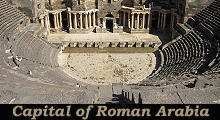 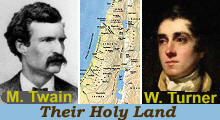 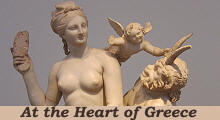 |
